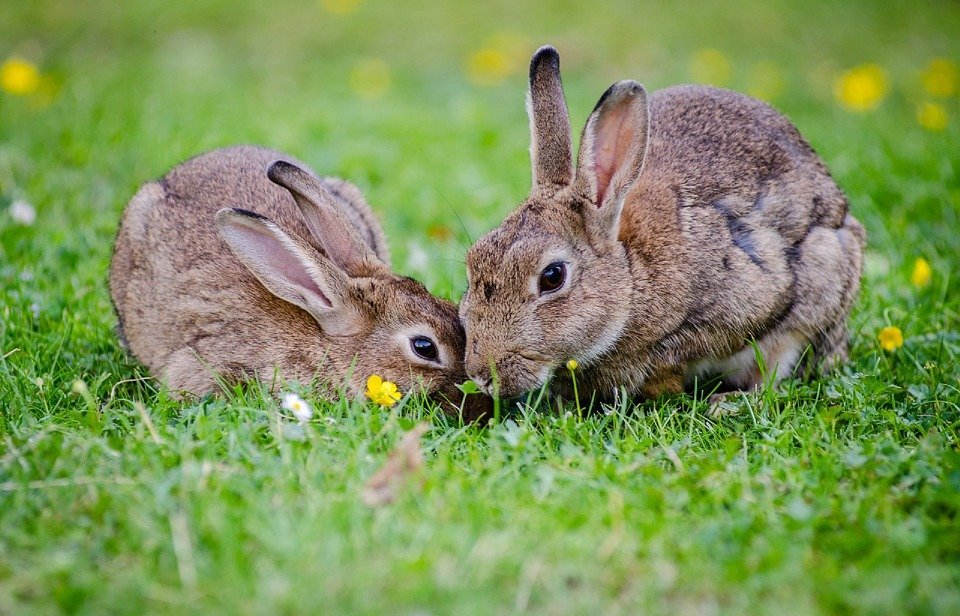Rabbits are often perceived as quiet, cuddly companions, but beneath their fluffy exterior lies a surprisingly expressive world of sounds. From gentle chirps to guttural growls, rabbits use a diverse repertoire of vocalizations to communicate their needs, feelings, and intentions. Understanding these sounds can unlock a deeper bond with your furry friend, allowing you to respond appropriately to their needs and navigate their often subtle communication. This guide dives deep into the fascinating world of rabbit sounds, providing a comprehensive understanding of their meanings and interpretations.
Part 1: The Silent Language of Rabbits

1.1 Beyond the Fluffy Exterior: The Importance of Rabbit Communication
Rabbits, despite their reputation for quietness, are social animals who rely on various forms of communication to navigate their complex world. While humans often focus on verbal language, rabbits primarily rely on non-verbal cues like body language, scent, and, yes, even sounds.
1.2 The Complexity of Rabbit Sounds: Beyond Simple Noises
Rabbit sounds are far from random noises. They are a sophisticated form of communication, carefully crafted to convey specific messages. Each sound, when interpreted within the context of their body language and environment, can reveal a wealth of information about a rabbit's emotional state, intentions, and even their physical wellbeing.
1.3 The Subtle Art of Rabbit Body Language: A Key to Understanding Sounds
While rabbit sounds are important, they are rarely understood in isolation. Rabbit body language is crucial for decoding their messages. A subtle twitch of the nose, a flick of the ears, a tense posture, or a rapid thumping of the feet can all provide vital context for interpreting their vocalizations.
Part 2: The Symphony of Sounds: Deciphering Rabbit Vocalizations

2.1 The Grunt or Growl: A Warning Sign or a Grumble of Discontent?
The low, guttural grunt or growl is often a sign of displeasure or a warning from your rabbit. It can signal that they are feeling threatened, uncomfortable, or are defending their territory. While not inherently aggressive, it's a clear sign that they need space or reassurance.
2.2 The Iconic Thump: A Sign of Excitement, Fear, or Both?
The iconic thump of a rabbit's powerful hind legs is a well-known sound. While it's often associated with excitement, it can also be a sign of fear, alarm, or even a combination of both. The force of the thump can vary, with more forceful thumps indicating a higher level of arousal.
2.3 The Soft "Chirp" of Contentment: A Gentle Sound of Happiness
A high-pitched chirp, often described as a "twitter", is typically a sign of contentment in a rabbit. They might chirp when they are happy, relaxed, or enjoying a particularly tasty treat. This sound often accompanies other signs of contentment, like grooming and gentle nibbling.
2.4 The "Brrr" Sound: Teeth Grinding for Comfort or Boredom
The "brrr" sound, produced by rabbits rubbing their teeth together, can be a sign of contentment, boredom, or a way to naturally grind down their ever-growing teeth. It's a common sound and usually nothing to be concerned about unless accompanied by other signs of distress.
2.5 The Strident "Shriek" of Fear or Pain: A Sound Calling for Immediate Attention
A loud, piercing shriek is a sign of extreme fear or pain in a rabbit. This sound is reserved for truly stressful situations and should be taken seriously. It may signal a need for immediate veterinary attention, especially if accompanied by other signs of distress.
2.6 Sniffling and Sneezing: Exploring the World or Signs of Illness?
Sniffling and sneezing are common behaviours in rabbits, especially when exploring their environment. While they can be signs of a cold or allergies, they are often simply ways for rabbits to gather information about their surroundings through scent.
Part 3: Getting to Know Your Rabbit's Voice: Building a Bond Through Sounds
3.1 Recognizing Individual Sounds: A Personal Language
Pay close attention to the various sounds your rabbit makes, and you'll begin to recognize their individual vocalizations. Over time, you'll learn what each sound means and can respond appropriately. This personalized understanding fosters a deeper connection.
3.2 Observing Body Language: The Complete Picture
Remember that sounds are only one piece of the puzzle. Combine careful observation of your rabbit's body language with their sounds to gain a comprehensive understanding of their emotional state. This holistic approach will help you accurately interpret their communication.
3.3 Building Trust and Understanding: The Gift of Communication
As you become more attuned to your rabbit's sounds, you'll notice how they respond to your voice and actions. This can help you build a stronger bond with your rabbit, fostering a deeper understanding and affection between you. This shared communication is a gift for both of you.
Part 4: Influencing Factors: Understanding the Nuances of Rabbit Sounds
4.1 Age and Gender: The Evolution of Communication
Younger rabbits tend to be more vocal than older ones. Females are often more expressive than males, especially during their breeding cycle. As rabbits mature, their vocalizations may become more subtle, but their body language remains an essential form of communication.
4.2 Breed Differences: A Symphony of Individuality
Certain rabbit breeds are known for their distinct vocalizations. For example, Dutch rabbits are often described as being particularly vocal. These breed-specific differences are part of what makes rabbits so fascinating.
4.3 Personality Matters: A Unique Voice for Every Rabbit
Just like humans, rabbits have their own unique personalities. Some are naturally more vocal than others, and some are more expressive with certain sounds. This individuality adds another layer of complexity to rabbit communication.
4.4 Environmental Influences: Context is King
Rabbit vocalizations can be influenced by their environment. Noise, stress, and other external factors can affect their communication patterns. Understanding these environmental influences can help you better interpret your rabbit's sounds.
Part 5: When Sounds Signal a Problem: Recognizing Signs of Distress
5.1 Unusual Sounds: Beyond the Normal Range
If your rabbit starts making new or unusual sounds, especially if they are accompanied by changes in behaviour, it's essential to contact your veterinarian. These changes could indicate a medical condition or an underlying issue that needs attention.
5.2 Excessive Vocalization: A Sign of Distress
Persistent and excessive vocalization, particularly if it is accompanied by other signs of distress, can indicate a medical condition that needs attention. Don't ignore these signs.
5.3 Pain and Distress: Seeking Immediate Veterinary Care
If your rabbit is making a high-pitched shriek or seems to be in pain, seek veterinary attention immediately. These sounds are a clear call for help and should not be ignored.
Part 6: FAQs: Understanding Rabbit Sounds
6.1. What does it mean when a rabbit growls at me?
A growl from a rabbit usually signifies displeasure, warning, or threat. It can indicate they are uncomfortable, scared, or are trying to protect their territory. It's a clear signal that they need space or reassurance.
6.2. Why does my rabbit thump its feet?
Thumping is a natural rabbit behaviour that can indicate excitement, fear, alarm, or a combination of these emotions. The force of the thump can vary depending on the rabbit's emotional state. It's a powerful way for them to communicate their feelings.
6.3. What can I do if my rabbit is making unusual noises?
If your rabbit is making new or unusual noises, observe their behaviour carefully. If they are exhibiting other signs of distress or illness, contact your veterinarian for a check-up. It's always best to err on the side of caution.
6.4. Are rabbit sounds a sign of a medical problem?
While some rabbit sounds are normal, others can be indicative of a medical condition. If you are concerned about your rabbit's sounds, it's always best to consult with your veterinarian. They can help determine if the sounds are a cause for concern.
6.5. How can I understand my rabbit better?
Pay close attention to your rabbit's vocalizations and body language. Spend time observing their behaviour in different situations and try to understand their individual personality and communication style. This dedicated observation is key to a stronger bond.
6.6. Can I teach my rabbit to understand my voice?
While rabbits are not as responsive to verbal cues as some other pets, you can still build a bond with them through positive reinforcement and consistent interaction. Using a calm, reassuring voice and positive body language can help your rabbit feel safe and comfortable around you.
6.7. Why does my rabbit grind its teeth?
Teeth grinding, or "brrring", can be a sign of contentment, boredom, or a way to naturally grind down their ever-growing teeth. It's a common behaviour and usually nothing to be concerned about unless accompanied by other signs of distress.
6.8. What are some ways to help my rabbit feel more comfortable?
Providing your rabbit with a safe and stimulating environment can help reduce stress and anxiety, which can in turn minimize the frequency of vocalizations related to fear or discomfort. This includes providing hiding places, enrichment toys, and a consistent routine.
Everyone is watching
-

Do Rabbits Lay Eggs? (The Surprising Truth)
OTHER TYPES OF PETSThis article will unravel the common misconception that rabbits lay eggs, exploring the fascinating world of r...
-

What's a Group of Rabbits Called? (A Comprehensive Guide)
OTHER TYPES OF PETSThis article delves into the fascinating world of rabbits, exploring the various terms used to describe a grou...
-

Can Rabbits Eat Grapes? A Guide to Safe Rabbit Treats
OTHER TYPES OF PETSThis comprehensive guide will explore the safety and suitability of grapes for rabbits, providing detailed inf...
-

Predators That Hunt Rabbits: A Guide to Natural Enemies
OTHER TYPES OF PETSI've always been fascinated by the circle of life, that delicate dance between predator and prey. Growing up ...
-

Are Rabbits Nocturnal Animals?
OTHER TYPES OF PETSThe question of whether rabbits are nocturnal animals is a fascinating one, with a surprisingly complex answer...
